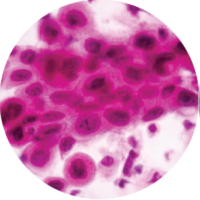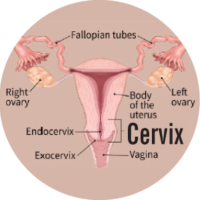
January is Cervical Health Awareness Month!
What is Cervical Health Awareness Month?
Cervical Health Awareness Month is a time to focus on the health and well-being of your cervix, because even though it might sound a little weird, cervical cancer affects around 13,000 women each year and results in about 4,000 deaths. Knowing how you can prevent cervical cancer is an important part of keeping yourself safe and putting your health first! Keep reading to learn more about how you can reduce your risk and what signs and symptoms you should watch out for.

Who can be affected by Cervical Cancer?
Women and those with a cervix who are sexually active are at risk for developing cervical cancer. Most cases of cervical cancer are caused by the Human Papilloma Virus (HPV), which is a sexually transmitted disease that spreads from person to person by someone who is already infected.
While there is no cure for HPV, many people will clear the virus naturally in about two years. However, the virus can also stick around and continue to infect the cells where it develops, like around your cervix. This can lead to cervical cancer as the virus turns normal cells into cancerous ones.
There’s no need to stress, though! Preventive measures to reduce your risk have come a long way and there are plenty of ways you can protect yourself. We’ll talk about that next!

So, what can I do to protect myself?
When it comes to protecting yourself against cervical cancer, perhaps the most important thing you can do is schedule routine screenings to receive either a Pap smear or HPV test. Depending on the results, your doctor can help you determine how often you should receive these screenings. It's recommended that women or those with a cervix receive their first Pap smear by the age of 21, regardless of whether or not they're sexually active.
Another way you can reduce your risk of developing cervical cancer is by getting vaccinated against HPV. The vaccine series (3 shots for those ages 15+; 2 shots for those ages 11-12) can help protect you from the various strands of HPV that can lead to cervical cancer.

How is Cervical Cancer detected and what are the symptoms?
Cervical cancer often takes years to develop (around 15-20 years for those with a healthy immune system), but that doesn't mean you can't detect signs of it early on. That's what makes a routine Pap smear so important. A Pap smear can help detect "precancers" or changes in the cells near your cervix that can lead to cancer.
If a Pap smear detects these changes, your doctor will talk to you about treatment options to avoid the risk of developing cervical cancer in the future. If you suspect you may have cervical cancer, the most common signs and symptoms are:
- Pelvic pain during sex
- Vaginal bleeding after sex not related to your monthly cycle
- Abnormal discharge with a foul smell

Prevent HPV, Prevent Cervical Cancer
Because a majority of cervical cancer cases are a result of an HPV infection, it’s important to practice safe sex like using condoms or getting yourself and your partners tested beforehand to avoid a possible HPV infection. In doing so, you can help keep yourself safe and further lower your risk.
If you need help finding a Pap smear service or HPV test, you can contact the Breast, Cervical and Colon health Program at SRHD at 509.323.2851 or you can learn more at: Cervical Cancer | SRHD
